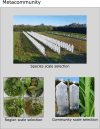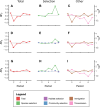Rapid Shifts in Relative Abundance Obscure Temporal Diversity Changes in a Metacommunity
- PMID: 40612546
- PMCID: PMC12222622
- DOI: 10.1002/ece3.71694
Rapid Shifts in Relative Abundance Obscure Temporal Diversity Changes in a Metacommunity
Abstract
Changes in biodiversity reflect processes acting at multiple spatial scales, from local to global, among habitats and within communities. This complexity makes it difficult to measure mechanisms that have traditionally interested ecologists, such as environmental filters. To resolve this, we propose an approach to partition temporal changes in biodiversity into contributions from selection at multiple scales. We applied this approach to study changes in the biodiversity of invertebrate herbivores from a large-scale, plant community experiment. Though the experiment was designed to foster distinct insect communities due to differences in host plants, our approach showed that selection among these treatments was a negligible facet of diversity change. These effects were swamped by rapid changes in relative abundances of aphids due to both immigration and selection across the metacommunity. More broadly, our work highlights how total change in biodiversity across a biogeographic region can be partitioned into logically distinct mechanisms.
Keywords: Hill numbers; beta diversity; community assembly; mesocosm; metacommunity; scale.
© 2025 The Author(s). Ecology and Evolution published by British Ecological Society and John Wiley & Sons Ltd.
Conflict of interest statement
The authors declare no conflicts of interest.
Figures





References
-
- Abrams, P. A. , and Wilson W. G.. 2004. “Coexistence of Competitors in Metacommunities due to Spatial Variation in Resource Growth Rates; Does R* Predict the Outcome of Competition?” Ecology Letters 7: 929–940.
-
- Agrawal, A. A. , Kotanen M. C., Mitchell E. A., Power G., Godsoe W., and Klironomos J.. 2005. “Enemy Release? An Experiment With Congeneric Plants Pairs and Diverse Above‐ and Belowground Enemies.” Ecology 86: 2979–2989.
-
- Barner, A. K. , Coblentz K. E., Hacker S. D., and Menge B. A.. 2018. “Fundamental Contradictions Among Observational and Experimental Estimates of Non‐Trophic Species Interactions.” Ecology 99: 557–566. - PubMed
Associated data
LinkOut - more resources
Full Text Sources

